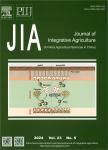Supplemental blue and red light promote lycopene synthesis in tomato fruits
Supplemental blue and red light promote lycopene synthesis in tomato fruits作者机构:College of HorticultureSouth China Agricultural UniversityGuangzhou 510642P.R.China
出 版 物:《Journal of Integrative Agriculture》 (农业科学学报(英文版))
年 卷 期:2019年第18卷第3期
页 面:590-598页
核心收录:
学科分类:0710[理学-生物学] 0832[工学-食品科学与工程(可授工学、农学学位)] 0830[工学-环境科学与工程(可授工学、理学、农学学位)] 1004[医学-公共卫生与预防医学(可授医学、理学学位)] 0905[农学-畜牧学] 0906[农学-兽医学] 09[农学] 0901[农学-作物学] 0703[理学-化学] 0902[农学-园艺学] 0713[理学-生态学] 090202[农学-蔬菜学]
基 金:supported by the National Key Research and Development Program of China (2017YFD0701500) the Teamwork Projects Funded by Guangdong Natural Science Foundation, China (S2013030012842) the Guangzhou Science & Technology Project, China (201704020058)
主 题:blue light red light lycopene phytochromes cryptochromes
摘 要:Lycopene, one of the strongest natural antioxidants known and the main carotene in ripe tomato, is very important for human health. Light is well known to be one of the most important environmental stimuli influencing lycopene biosynthesis; specifically, red light induces higher lycopene content in tomato. However, whether blue light promotes lycopene synthesis remains elusive and exactly how light stimulation promotes lycopene synthesis remains unclear. We applied supplemental blue and red lighting on tomato plants at anthesis to monitor the effect of supplemental blue and red lighting on lycopene synthesis. Our results showed that supplemental blue/red lighting induced higher lycopene content in tomato fruits; furthermore, we found that the expression of key genes in the lycopene synthesis pathway was induced by supplemented blue/red light. The expression of light signaling components, such as red-light receptor phytochromes(PHYs), blue-light receptor cryptochromes(CRYs) and light interaction factors, phytochrome-interacting factors(PIFs) and ELONGATED HYPOCOTYL 5(HY5) were up-or down-regulated by blue/red lighting. Thus, blue and red light increased lycopene content in tomatoes by inducing light receptors that modulate HY5 and PIFs activation to mediate phytoene synthase 1(PSY1) gene expression. These results provide a sound theoretical basis for further elucidation of the light regulating mechanism of lycopene synthesis in tomatoes, and for instituting a new generation of technological innovations for the enhancement of lycopene accumulation in crop production.



